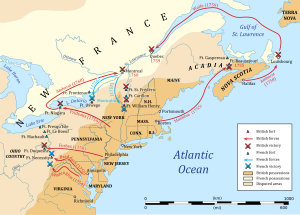French and Indian war
| French and Indian War | |||||||||
|---|---|---|---|---|---|---|---|---|---|
| Part of the Seven Years' War | |||||||||
 The war theatre |
|||||||||
|
|||||||||
| Belligerents | |||||||||
|
Catawba Cherokee (before 1758) |
Algonquin Lenape Ojibwa Ottawa Shawnee Wyandot |
||||||||
| Commanders and leaders | |||||||||
|
Jeffery Amherst Edward Braddock † James Wolfe † Earl of Loudoun James Abercrombie Edward Boscawen George Washington John Forbes George Monro |
Louis-Joseph de Montcalm † Marquis de Vaudreuil Baron Dieskau (POW) François-Marie de Lignery † Chevalier de Lévis (POW) Joseph de Jumonville † Marquis Duquesne Daniel Lienard de Beaujeu † |
||||||||
| Strength | |||||||||
| 42,000 regulars and militia (peak strength, 1758) | 10,000 regulars (troupes de la terre and troupes de la marine, peak strength, 1757) | ||||||||
British victory
The French and Indian War (1754–1763) comprised the North American theater of the worldwide Seven Years' War of 1754–1763. The war pitted the colonies of British America against those of New France, with both sides supported by military units from their parent countries of Great Britain and France, as well as by Native American allies. At the start of the war, the French North American colonies had a population of roughly 60,000 European settlers, compared with 2 million in the British North American colonies. The outnumbered French particularly depended on the Indians. Following months of localised conflict, the metropole nations declared war on each other in 1756, escalating the war from a regional affair into an intercontinental conflict.
...
Wikipedia
